Mark R. Gornik
Practicing Faith in the Inner City
Books discussed in this essay
Andrew Billingsley, Mighty Like a River: The Black Church and Social Reform (Oxford Univ. Press, 1999).
Robert D. Carle and Louis A. DeCaro, Jr., eds. Signs of Hope in the City: Ministries of Community Renewal (Judson Press, rev. ed., 1999).
Roberta Brandes Gratz with Norman Mintz, Cities Back from the Edge: New Life for Downtown (Wiley, 1998).
Paul S. Grogan and Tony Proscio, Comeback Cities: A Blueprint for Urban Neighborhood Revival (Westview Press, 2000).
Nile Harper and associates, Urban Churches, Vital Signs: Beyond Charity Toward Justice (Eerdmans, 1999).
Katherine S. Newman, No Shame in My Game: The Working Poor in the Inner City (Alfred A. Knopf/Russell Sage Foundation, 1999).
Cheryl J. Sanders, Ministry at the Margins: The Prophetic Mission of Women, Youth and the Poor (InterVarsity, 1997).
Stanley P. Saunders and Charles L. Campbell, The Word on the Street: Performing the Scriptures in the Urban Context (Eerdmans, 2000).
Amy L. Sherman, Restorers of Hope: Reaching the Poor in Your Community with Church-Based Ministries That Work (Crossway, 1997).
Ray Suarez, The Old Neighborhood: What We Lost in the Great Suburban Migration, 1966-1999 (Free Press, 1999).
Jim Wallis, Faith Works: Lessons from the Life of an Activist Preacher (Random House, 2000).
William Julius Wilson, The Bridge Over the Racial Divide: Rising Inequality and Coalition Politics (Univ. of California Press/Russell Sage Foundation, 1999).
Robert L. Woodson, Sr., The Triumphs of Joseph: How Today's Community Healers Are Reviving Our Streets and Neighborhoods (Free Press, 1998).
Two miles west of Baltimore's tourist-packed and stadium-lined inner harbor, and just a mile or so further from Fort McHenry where the "Star Spangled Banner" was composed, is the inner-city neighborhood of Sandtown. The prevailing public sentiment about Sandtown has long been, "Can anything good come from here?" Because the gospel is good news for the poor, the answer is of course, yes. Today there are many remarkable things taking place, and one catalyst has been New Song Community Church. Having heard the cry of God in the cries of the community, the church has seeded an ensemble of community development initiatives. A neighborhood health center serves all residents regardless of insurance or ability to pay, a housing corporation has replaced blocks of vacant houses with units sold for community ownership, a multi-grade school enables children to succeed, and a job placement program links working-age unemployed people to a ladder of employment. At the center is the church, with its worship and witness animating the process. The cumulative result is that block-by-block, God's shalom is being advanced.
Skeptics may find this account too good to be true. To them I say, visit Sandtown, take a look for yourselves. In fact, New Song's Christian community development efforts are just one very small part of a much larger story of urban faith and discipleship under the heading of "church-based" or "faith-based" ministry. President George W. Bush's announcement of a new White House Office of Faith-Based and Community Initiatives has drawn attention to often unheralded success stories—and raised concerns among critics and allies. Despite ongoing debate, Bush's actions promise to quicken the pace of public and religious partnership in social services and community development that has been underway for the past decade and longer.
Clearly, there has been a reversal of evangelical withdrawal from social ministry and concern, a historical change that deserves celebration. But in our time of ballooning national plenty, is too little being said about the reasons why a work such as New Song is even still required? Are we too concerned with the deeds of compassion and not critical enough about the needs for a more just social world? In the books discussed in this essay—and there are more now on this subject than ever before—we are helped not only to think about what congregations are doing and can be doing better, but also to reflect on the conditions of urban America that call faith-based ministries into being.
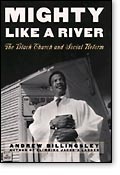
Mighty Like a River
The place to start is the black church. Andrew Billingsley's important book, Mighty Like a River: The Black Church and Social Reform, reminds us that the black church has always worked for justice, built community, and engaged in "holistic ministry" well before it ever went by such a name. Billingsley's accounts of contemporary urban ministry are compelling case studies. Although his book occasionally feels like a research project still in process, its central storyline of the black church experience is inspiring.
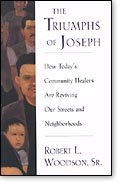
The Triumphs of Joseph
Robert L. Woodson, Sr., is the founder and president of the National Center for Neighborhood Enterprise in Washington, D.C. In The Triumphs of Joseph: How Today's Community Healers Are Reviving Our Streets and Neighborhoods, Woodson celebrates the "Josephs," men and women at the neighborhood level who overcome their circumstances and become catalytic leaders for change. These are leaders who live with integrity no matter the personal cost, as did Joseph in the book of Genesis. "Grassroots Josephs may not have degrees and certifications on their walls," Woodson writes, "but they do have this—the powerful, uncontestable testimonies of people whose lives have been salvaged through their work."
Woodson is also concerned about the "Pharaohs" whom the "Josephs" must overcome. For Woodson, the Pharaohs are those who have a vested interest in keeping the poor in conditions of need and dependence—including, in his judgment, the "civil rights establishment, the poverty industry, and their political affiliates who will not easily relinquish their position as custodians of the poor nor their 'ownership' of the problems of poverty."
Stressing community solutions over official programs, "Josephs" over "Pharaohs," Woodson has long advocated a new way of operating, one that brings public support to those on the frontlines of urban renewal. Still, such support, he argues, need not entail eliminating public involvement in low-income neighborhoods. Indeed, Woodson attempts to chart a third way that is neither government disengagement nor a resurrection of Great Society liberalism. (If this sounds something like "compassionate conservatism," Woodson, it should be noted, has advised Bush on these matters. Then-Senator John Ashcroft, Senator Joseph I. Lieberman, and Stephen Goldsmith, now a key adviser to Bush on faith-based initiatives, endorsed Woodson's book.)
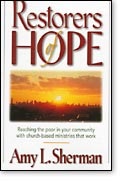
Restorers of Hope
Focusing on faith-based programs in the inner city, Amy L. Sherman's concern is to identify working models and draw from them key principles for church programs and involvement. A widely published writer on social policy, Sherman also has firsthand experience in urban ministry. In Restorers of Hope: Reaching the Poor in Your Community with Church-Based Ministries That Work, she profiles seven "Restorers" (emphasis is the author's)—evangelical churches and Christian organizations that engage in "tough love" ministries of mercy which make important differences in peoples' lives. She makes a strong case for the vitality and commitment of these ministries and provides practical direction that many congregations will find helpful.
Using the profiled groups as examples, Sherman sets out ways that a local church or ministry can address the needs of the poor in what she stresses must be personal and hands-on ways. Her interest in both ministry dynamics and public policy underlies her critical analysis of the strengths and weaknesses of forming partnerships with government agencies. While positive about finding a way to work with government, Sherman cautions about entanglements that may compromise the spiritual message and relational core of ministry.
In her introduction, Sherman writes,
The now-accepted assumption that personal behavior, values, and attitudes impact one's economic prospects has led many people to ask what can be done to transform ghetto culture. … Even positive reforms in welfare policies, such as those aimed at "getting the incentives right," though necessary, are insufficient. Public policy changes alone cannot reform behavior; personal transformation requires more than legislative reforms. It requires "holistic ministry"—that is, attention to a person's "whole" being (his/her emotional, physical, mental, and spiritual state).
And she goes on later to say,
Restorers do not deny that environmental factors contribute to the persistence of poverty. Many of their efforts. … address structural problems faced by the poor. However, Restorers argue that behavioral factors are equally, if not more, important in explaining poverty. Consequently, Restorers are not afraid to talk about sin and to exhort individuals to change their behavior.
Sherman is arguing for outreach efforts aimed at bringing about personal, moral, and cultural change among the poor. But frequently what lies between the lines of such analysis—which exemplifies what seems to be the reigning viewpoint on faith-based ministry—is a deeply flawed understanding of the causes of urban poverty. All too often, talk about personal responsibility serves subtly or not so subtly to deflect attention from structural injustice. That need not follow from an emphasis on spiritual transformation, but in practice it often does.
I believe, as I've said, that the gospel is good news for the poor, dramatically changing lives and communities from the bottom up. Yet I want to take issue with the notion that the personal sins and failures of inner-city residents are at the center of inner-city poverty. From 1986 until a few years ago, I lived as a pastor and neighbor in Sandtown. As I reflect on my neighborhood and the struggles for life which people there face every day, I see no way around recognizing racial oppression and economic exclusion as key factors in inner-city dislocation. In fact, I believe they are among the most prominent causes. Two examples, one from the world of work and the other from housing, illustrate this.
In Baltimore, there are simply not enough "low-skill" jobs for people who need them, and few of the jobs that are available provide a living wage. People who want to enter or move up in the labor market still find more barriers than bridges, including geographical proximity and racially discriminatory employer perceptions.
To address this problem, New Song Community Church started a job placement program, which, under the leadership of Nina Anderson, a longterm resident, is making a big difference. But there is much more that needs to be done amid the post-industrial and now global transformations of work. With the strong economy, cities are seeing significant drops in unemployment, which I think establishes how much people want to work. However, isolated communities like Sandtown are only modestly affected by such trends, and wages remain low. With the economy slowing, tentative gains look to be lost.
Thanks to the film and television director Barry Levinson, Baltimore is well known for its brick row houses with marble front steps. From the outside, they look decent enough, even beautiful if one appreciates their egalitarian form. Going inside often tells another story. In inner-city neighborhoods such as Sandtown, these row houses are often in disgraceful physical condition: floors with holes, illegal electrical systems, rats, lead paint, broken bathroom fixtures—all this and more.
I remember how distressed I was after my first pastoral visits. Having grown up just 20 minutes away in the suburbs, I had known almost nothing of this reality. I learned that absentee landlords were exploiting the neighborhood by collecting multiple deposits, charging high rents, and ignoring housing codes. People were paying the purchase price of rental housing many times over, but never owning or building equity. When landlords could no longer make money, they abandoned their properties. That is why establishing a home-ownership program was so vital, and thanks to a decade of hard work, 150 Sandtown families no longer live in substandard rental housing, but enjoy decent and affordable housing they now own.
We must not forget that when the Hebrew prophets talked about the plight of the poor, they focused not on the behavior of the poor, but on the behavior of the privileged and powerful. The cross deconstructs moral superiority. And the faith that sets women and men free, the grace of justification, releases them to work passionately for social justice and the good of their neighbors.
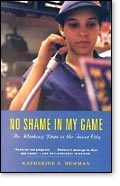
No Shame in My Game
Katherine S. Newman, an anthropologist now at Harvard University, has written a book that should at least give pause to those whose understanding of urban poverty is shaped by an individualistic framework. In No Shame in My Game: The Working Poor in the Inner City, Newman examines the world of "invisible" low-wage workers in central Harlem. Concentrated joblessness, the result of structural changes in the economy, is a defining inner-city reality, as the sociologist William Julius Wilson has amply documented. But as Newman shows, so are the challenges of making ends meet in a low-wage job.
Some years ago, when Newman was in a cab going through Harlem, she noticed how the streets were filled with people on the way to work. This stood in contrast to the stereotype of laziness many have of the inner city. Working with students at Columbia University, where she then taught, Newman interviewed people working at a fast-food chain, identified in her book by the fictitious name "Burger Barn." Newman reports that "Burger Barn" workers labor incredibly hard, find their way through many complicated situations, and achieve many successes, yet they do so largely without receiving health insurance, disability coverage, or a wage that will solidly lift them and their families out of poverty. Newman's study of the working poor in central Harlem is a major contribution to research on the inner city and deserves wide reading.
A number of reviewers of Newman's study have commented on issues of personal responsibility and character in the individuals she profiles. Is she too quick to offer excuses for people who have made bad decisions? While personal responsibility is not to be bracketed out, macro issues such as wages and access to health care matter considerably more than the champions of responsibility typically acknowledge. If a working single parent is sick and cannot afford medicine and then loses her job, that is not a problem of personal character. Such crises are all too common among inner-city families in our winner-take-all economy. Indeed, as Harlem stands at the epicenter of a global city, the pressures on the poor and working class have grown dramatically. Newman's book, for all its emphasis on wages and job prospects, does not, in my judgment, avoid seeing the brokenness of people's lives.
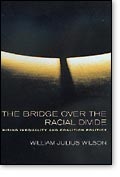
The Bridge Over the Racial Divide
It is important to remember that the questions of stable employment and access to health care are not just inner-city issues, but matters that confront all working American families. As William Julius Wilson proposes in The Bridge Over the Racial Divide, such conditions provide the basis for organizing multiracial coalitions that benefit many segments of society—including, but not limited to, the urban poor.
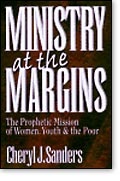
Ministry at the Margins
For Christians, social and economic inequality is a distinct gospel challenge. It must be if divine reconciliation makes all things new. A prophetic voice for evangelicals is Cheryl V. Sanders, a professor at Howard University School of Divinity and a pastor with Third Street Church of God in Washington, D.C. In Ministry at the Margins: The Prophetic Mission of Women, Youth and the Poor, Sanders argues that biblically, the poor are not objects to be served or consulted but subjects of their own future. In Christ, God empowers the excluded to be agents of change, overcoming racism and oppression. This is a way of seeing the world that can take us away from paternalism, a residual tendency for the evangelical church.
Sanders's passion, she writes,
is to empower the church to embrace a fresh anointing to overcome evil with good by bringing evangelical faith and fervor into harness with an ethic of equality and justice for all, so that the ministry, mission and message of Christ can emerge into the third millennium with renewed authority and impact.
The gospel calls Christians to the task of mission in the public place, and Sanders explores this demand from a number of biblical perspectives. In a chapter on the Golden Rule, she writes,
Whoever we are and whatever our station in life, the Golden Rule gives us authority to take the moral initiative to do good in the world, to give priorities to the plans and expectations that God has placed before us, to let God's goodness be produced and multiplied in us, even to the benefit of enemies and oppressors.
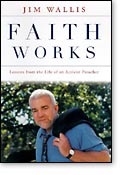
Faith Works
In Faith Works: Lessons from the Life of an Activist Preacher, Jim Wallis, convener of the Call to Renewal and editor of Sojourners magazine, advocates a view of urban poverty that seeks to take into account both the individual and the social context. His stories of ministry cover a wide range of faith-based activities, alliance building, and poverty fighting initiatives that are equally encouraging and challenging. Reading this book, it really does seem that a new movement is underway. With autobiographical anecdotes that range from the streets to Harvard classrooms, Wallis also offers "how to" advice on the link between spirituality and social action.
Wallis is among the leading American evangelical social activists and an important public apologist for an integral Christianity. Therefore it is interesting to compare this book to his earlier writing, work full of continuities yet in the past more explicitly theological and church-oriented. I hope that Wallis at some point will address how the more inclusive public faith he now advocates relates to the sort of intentional, gospel-shaped witness for which he and the Sojourners community have been known. That is not on the agenda of Faith Works, at least explicitly, but I think it is an important question.
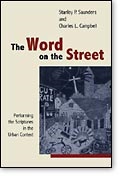
The Word on the Street
Is there more to urban poverty than social forces? Two Columbia Theological Seminary professors visit this question through the lives of Atlanta's homeless. In The Word on the Street: Performing the Scriptures in the Urban Context, Stanley Saunders and Charles Campbell provide a thoughtful social and theological contribution to urban ministry. Influenced by their street experiences with homeless persons, mediated through the intentional life of hospitality offered by the Open Door Community, they offer a rich fare of theological and pastoral analysis. Following such writers as Walter Wink and William Stringfellow, Saunders and Campbell argue that the "principalities and powers" play a major role in creating a world of rejection. In resistance to the powers, their emphasis falls on witness, preaching, worship, solidarity, and community.
Saunders and Campbell teach New Testament and homiletics respectively, and their book demonstrates what can happen when seminary professors get out of the classroom and onto the streets. For all the strengths of their project, I mention some questions. What is the role of the scholar in telling the story of the poor? When "the stranger keeps knocking," should we not also hear the need to engage in social reform, community organizing, and the development of affordable housing? Is their Christologically dense argument not dense enough?
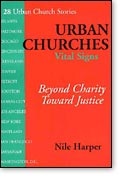
Urban Churches, Vital Signs
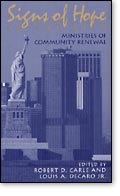
Signs of Hope in the City
Case studies are always good ways to learn of what churches and faith-based organizations are doing in the city. Nile Harper's Urban Churches, Vital Signs is one such volume (full disclosure: New Song in Baltimore is one of the churches profiled). What of an entire city as a church-and-community case study? Signs of Hope in the City: Ministries of Community Renewal, edited by Robert D. Carle and Louis A. DeCaro, Jr., provides us with fascinating perspective on New York City. With its origins in a citywide consultation on urban ministry (linked to the work of Ray Bakke and his International Urban Associates), this volume profiles the church in New York alive in many voices and motions: Asian, Latino, African American, and Anglo.
As the essays make clear, the church is at the heart and soul of urban life. Indeed, New York as "secular city," when viewed from the vantage point of its "outer boroughs" such as Queens, Brooklyn, and the Bronx, is a myth. Several essays tell how congregations have played key roles in renewing parts of the South Bronx and Harlem through community organizing and development. (In a point we cannot elaborate here, organizing, long part of our evangelical heritage, belongs back on the church's agenda.) Typically the initiatives in New York were taken in partnership with local government. Another section introduces ministries of mercy, especially to the homeless.
A great strength of this book is its diversity of models for different circumstances and settings. While some of the introductory statistical and sociological assumptions await challenge and perhaps adjustment, Signs of Hope in the City provides readers with a valuable introduction to the diverse scope of Christian presence in New York City and, by extension, in cities around the world.
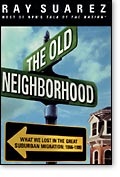
The Old Neighborhood
Any discussion of urban matters needs to bring into play America's postwar abandonment of its cities. With his very readable The Old Neighborhood: What We Lost in the Great Suburban Migration, 1966-1999, Ray Suarez takes us to the city as home, not a cold and heartless place. According to Suarez, whom many will recognize for his previous work with National Public Radio and now with the pbs Newshour, the migration of people from our cities over the past half century, in particular from the rust belt, has dramatically affected our social, economic, and political life. Think of cities such as Baltimore, Detroit, Philadelphia, and St. Louis, places that continue to empty out.
The sense of community that characterized city life has never been recovered in the suburbs, and the destructive impact in terms of a declining tax base and uneven metropolitan development remains. With his tour of urban neighborhoods, Suarez tries to help us understand the importance of cities in all of their changing dynamics, struggles, and possibilities. He reminds us that while our cities will keep going, staggering into the future, the cost of not assisting them will ultimately be borne by all of us.
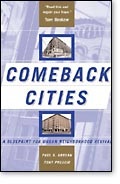
Comeback Cities
Yet are we beginning to see a turnaround? Paul Grogan and Tony Proscio contend that we are. In Comeback Cities: A Blueprint for Urban Neighborhood Revival, they recount wonderful examples of urban recovery, especially in "undercrowded" settings. Grogan and Proscio document a new "non-ideological" approach well underway, one that favors support for community-based groups, decentralized public services, retail investment, and public safety. Grogan, who for 13 years ran the Local Issues Support Corporation (LISC), a national community development intermediary, had a major role in the community development movement. Comeback Cities is the best introduction and defense of community development and results-oriented urban policy that I know of. It is a work that shows how we can reverse the decline of our cities while empowering local communities.
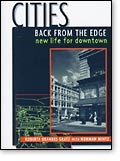
Cities Back from the Edge
For another celebratory view of urban possibility that is definitely worth reading, see Robert Brandes Gratz's Cities Back from the Edge: New Life for Downtown. Its stories and principles of urban development show the way to maintaining healthy built environments. Gratz's views on urban stewardship set working standards for an ethical urbanism.
We are left with at least three questions to think further about. First, how do we make a connection between relational activities of faith and the pursuit of public justice? Voluntary compassion will not transform the fallen systems and structures of the inner city. Because Jesus is Lord over all, we need Christian thinking to engage more fully matters of urban policy, economy, governance, and development, but always through the eyes of the least of these among us. Urban faith is a public task.
Second, what does it mean to be the church in a divided and conflicted urban world? In many ways, the future lies especially in congregations that proclaim the grace of justification and the demands of jubilee justice. They will be communities that intentionally embody the habits, practices, and convictions of the peaceable reign of God in concrete localities. Particularly important will be grassroots communities of faith who pray and read Scripture together, share their food and their faith, work together for better housing, see that health care and addictions treatment is available for all, enhance local schools and even create new ones, see that daycare for working parents is established, press for living-wage jobs for those left out of the labor market, and welcome the stranger.
Third, how are we to have the mind of Christ regarding government support of faith-based initiatives? There is no question that faith brings incredible motivation to service, and believing that every person is created in the image of God is a foundation for ministry that will have a life-changing impact on people. More funding almost always helps, and it potentially will benefit many grassroots Christian ministries. As a Reformed Christian, I believe all of life is religious, and God's purposes of shalom are for the entire human community. But I believe that for government funding, the faith factor needs to be directed toward measurable results, not inner personal or heart change. If over the next few years this issue is wrongly handled, if the constitutional questions are not dealt with honesty by ministries, the setback could be substantial.
But whether or not to accept government funding—and Charitable Choice is presently a key way—is perhaps not the main issue for Christians involved in urban ministry. I worry more about the confusion of a neo-Constantinian patronage with Christian mutuality and a paternalistic "helping" that forgets Amos's and Micah's calls for justice.
Let us not forget that for all the good-news stories of recovery and resurrection, the work ahead in our cities remains both immense and increasingly more complex in a post-welfare, global economic era. New challenges are emerging as old ones remain, and in all of this, it is the city, the future of the world, where the people of God are called to practice their faith. Working alongside America's urban poor should lead to Christian indignation at the gap between rich and poor, the continuation of racism, and deep patterns of structural injustice. All of us should be broken by the brokenness of the world. But knowing God's future of shalom for the city, a world without tears, the church is to witness and follow Christ in his way, the way of the cross.
Mark R. Gornik, the founding pastor of New Song Community Church in Baltimore, is currently living in New York City, where he helped to begin New Song Community Church in Harlem. His book To Live in Peace: Biblical Faith and the Changing Inner City will be published by Eerdmans later this year.
NOTE: For your convenience, the following books, which were mentioned above, are available for purchase:
• Mighty Like a River, by Andrew Billingsley
• Signs of Hope in the City, by Robert D. Carle and Louis A. DeCaro, Jr.
• Cities Back from the Edge, by Roberta Brandes Gratz with Norman Mintz
• Comeback Cities, by Paul S. Grogan and Tony Proscio
• Urban Churches, Vital Signs, by Nile Harper and associates
• No Shame in My Game, by Katherine S. Newman
• Ministry at the Margins, by Cheryl J. Sanders
• The Word on the Street, by Stanley P. Saunders and Charles L. Campbell
• Restorers of Hope, by Amy L. Sherman
• The Old Neighborhood, by Ray Suarez
• Faith Works, by Jim Wallis
• The Bridge Over the Racial Divide, by William Julius Wilson
• The Triumphs of Joseph, by Robert L. Woodson, Sr.
Copyright © 2001 by the author or Christianity Today/Books & Culture Magazine.
Click here for reprint information on Books & Culture.








Displaying 0–0 of 0 comments.
Displaying 0–0 of 0 comments.
*